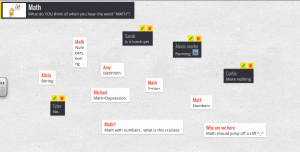This post was cross-posted from our TLLP Blog: http://personalizinglearning.ca/
We officially wrapped up our TLLP today. It was bitter sweet. As we looked back at our learning and reflected on the capacity built within our school this year we are flabbergasted. It has been an excellent year for developing a culture of learning and sharing among staff, moving forward in our learning as a group. We were able to personalize learning for all staff to honour all starting points and needs.
In June of 2013 we did a “pre” survey and this June 2014 we completed a “post” survey. This survey included all teachers on staff, not just the TLLP core team. Our TLLP was designed to include staff from all areas of the school as we moved through the year.
The first part of our survey asked teachers to self-assess themselves on the five main competencies outlined in the ISTE Standards for Teachers. They were assessing themselves as either ‘beginning, developing, proficient or transformative’. From this first part of the survey we learned the following:
- we feel we made a slight improvement in “facilitate and inspire student learning and creativity”. This area was already high.
- the folks who were proficient in “designing and developing digital age learning experiences and assessments” shifted up to transformative levels, but not many “beginners” moved. This is an area of great need for us.
- a large shift in “model digital age work and learning”. This area was quite low before this year – we demonstrated impressive gains.
- substantial improvement in “promote and model digital citizenship and responsibility”. This area was already fairly high.
- a large shift in “engage in professional growth and leadership”. We were quite low and have shown large improvements.
I find it very interesting that teachers feel they have made excellent movement in their own selves as learners in the 21st century and modelling working in the digital age. It makes perfect sense to me that our next area of great need is to design and collaborate on creating ‘digital age learning experiences and assessments’.
Next, we asked a variety of questions and learned the following:
Types of future learning desired by teachers:
- specific requests for 1:1 expert training and small group setting supports.
- A shift out of “workshops about specific digital tools” and into “release time to work with other colleagues co-planning” and “attending conferences”.
- Request for watching or visiting colleagues classrooms remained the same
Specific digital tools support:
- More “creation” tool support requested
- D2L requests stayed the same, but with specific higher-end tool support opposed to beginner requests
- Huge increase in requests for Google Apps support
Essential Practices
- Specific requests to support providing descriptive feedback digitally
- Increase in requests for developing class or learner profiles
- Decrease in requests for differentiated instruction, but an increase in differentiated assessment
Again, these responses make sense to me and show a further need for co-creating assessment and learning experiences.
We began the year focused on the “mechanics of BYOD”. We communicated with teachers that as we head into September 2014 (where all grade 9’s are bringing in devices) that teachers had to have the following four mechanics sorted out, but that they could choose any tools to accomplish these goals that they wished (we provided supports and examples of all the major players).
- Share information to students (files, material, links, media, etc.)
- Receive information from students (documents, links, video, audio)
- Provide descriptive feedback digitally
- Provide a space for facilitated online student collaboration (discussion, sharing resources and collaboration)
As we moved throughout the year, we focused our efforts more and more away from the mechanics on more on defining what “Blended Learning” is and on creating differentiated assessments and providing descriptive feedback online. As we built capacity throughout the year, more and more teachers wanted to be involved. Our school board Program department graciously supported some additional collaboration (with release time) as we ran out of release time quite early in the year.
It sure was an excellent year and our reflection has provided us with some clear direction for moving forward. Many teachers expressed a sadness that our TLLP was at an end. I can honestly say that I have never seen such movement in terms of a large group of teachers transitioning into truly owning and directing their own learning. Each one of our collaborations was guided by participating teacher suggestions and ideas (not my ideas as a the leader, but participating teachers). Thanks to all the teachers who stepped up and were involved in this years TLLP at MSS and PSS!
 er Jen Lachapelle have her students create a padlet on the first day about what they think of when hear the word math. It provided a great base for an honest, deep conversation on the first day. Her class has also done some online polling and discussions.
er Jen Lachapelle have her students create a padlet on the first day about what they think of when hear the word math. It provided a great base for an honest, deep conversation on the first day. Her class has also done some online polling and discussions.